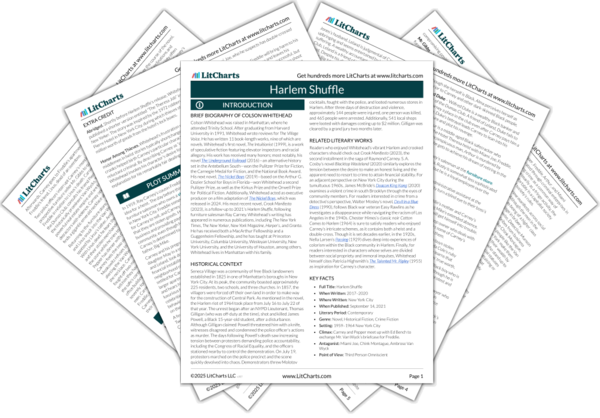Welcome to the LitCharts study guide on Colson Whitehead's Harlem Shuffle. Created by the original team behind SparkNotes, LitCharts are the world's best literature guides.
Harlem Shuffle: Introduction
Harlem Shuffle: Plot Summary
Harlem Shuffle: Detailed Summary & Analysis
Harlem Shuffle: Themes
Harlem Shuffle: Quotes
Harlem Shuffle: Characters
Harlem Shuffle: Symbols
Harlem Shuffle: Theme Wheel
Brief Biography of Colson Whitehead

Historical Context of Harlem Shuffle
Other Books Related to Harlem Shuffle
- Full Title: Harlem Shuffle
- When Written: 2017–2020
- Where Written: New York City
- When Published: September 14, 2021
- Literary Period: Contemporary
- Genre: Novel, Historical Fiction, Crime Fiction
- Setting: 1959–1964 New York City
- Climax: Carney and Pepper meet up with Ed Bench to exchange Mr. Van Wyck’s briefcase for Freddie.
- Antagonist: Miami Joe, Chink Montague, Ambrose Van Wyck
- Point of View: Third Person Omniscient
Extra Credit for Harlem Shuffle
Abridged. Shortly before Harlem Shuffle’s release, Whitehead published a shorter version entitled “The Theresa Job” in The New Yorker. The story was inspired by the 1972 robbery of the Pierre Hotel in New York City, during which thieves stole $28 million worth of goods from the hotel’s lock boxes.
Honor Among Thieves. Whitehead’s frustration with the way middlemen in heist stories typically shortchange the hero-crooks helped birth Carney’s particular characterization as a reluctant criminal. By describing Carney as “only slightly bent,” Whitehead invokes his character’s desire for morality as an explanation for his remarkably fair dealings with criminals.







